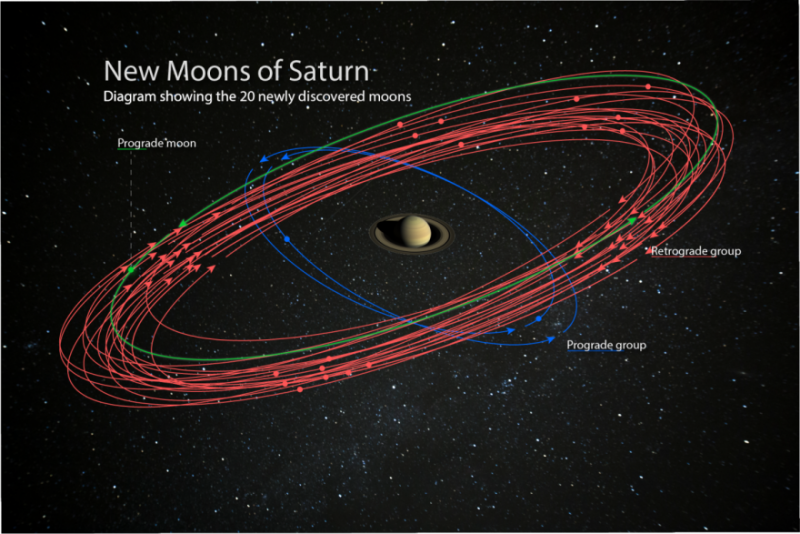20 new moons found orbiting Saturn
May 30, 2020
Saturn has many notable characteristics that distinguishes it from other planets in the Solar System. Apart from its lustrous rings, Saturn is the second largest planet in the Solar System with its largest moon Titan, which also happens to be the second largest moon in the Solar System.
Yet, Saturn always seemed to play second fiddle to the King of the Planets, Jupiter, and its planet-sized moon Ganymede.
However, this has finally changed with the discovery of 20 new moons orbiting the Ringed Planet, trumping Jupiter and becoming the planet with the largest amount of moons in the Solar System with a grand total of 82.
The discovery was reported on Oct. 7, and was made by a team headed by Scott Sheppard of the Carnegie Institution for Science using the Subaru telescope in Hawaii. The team had found 20 moons, all about three miles wide, with 17 in retrograde orbit, or orbiting in the opposite direction of Saturn’s rotation, and the other three in prograde orbit, aligned with Saturn’s rotation.
These new moons are far out. The closest moon discovered, affectionately labeled S5605a2 S/2004 S37, orbits Saturn at a distance of 16 million kilometers, about 10 million miles, and takes about two years to complete its orbit. These moons are distant from Saturn when compared to Earth’s own lunar system.
“They’re very far out, tens of millions of miles out. …Earth’s moon is about a quarter million miles away,” according to Tony Dunn, physics teacher.
“They’re very far out, tens of millions of miles out.
— Tony Dunn '82, science teacher
Saturnian moons are categorized by the inclination of their orbits, which is measured by the angle made between the moon’s orbital plane, the geometric plane produced by the orbit, and Saturn’s equatorial plane, the geometric plane that extends from Saturn’s equator. Two of the prograde moons, including our friend S5605a2 S/2004 S37, orbit closer to the planet than the other moons and have an inclination of around 46 degrees, which makes them part of the Inuit group. The other prograde moon is much farther with an orbit that takes about three years and has an inclination of 36 degrees, and therefore is a part of the Gallic Group.
The other 17 retrograde moons take about three years to complete an orbit and are all in the same group: the Norse. Because of their similar inclination and distance, some astronomers theorize that these moons and other moons in the Norse group are remnants of a larger moon becoming shattered by an object or Saturn’s gravity in the past. The study of the orbital inclination of moons can give hints about their origin, but where these moons came from is still an area of study.
While this discovery was a great one for moon fanatics and Saturn sympathizers alike, it is very likely that this is not going to be the last for any of the gas giants. As technology continues to improve, telescopes are becoming more sensitive and adaptive to finding three-mile-wide objects as far out as Saturn. However, many scientists want to use the high powered telescopes for many different reasons, not all including moons.
Dunn said, “The telescopes powerful enough for finding these things are in high demand.”
Because of this, moon discoveries may not be as frequent as they could be.
This revelation mirrors a discovery last year, where Sheppard discovered 12 new moons around Jupiter, propelling the King to the top of the moon ensemble.
“Maybe next year there’ll be an article, it says Jupiter reclaims the title as scientists announce 15 more moons, but right now, what we know is Saturn’s got more moons,” Dunn stated.
While Saturn’s supremacy is not definitive, with its addition for 20 new little moons, the Ringed Giant can rest with an established supreme total of 82 natural satellites.













